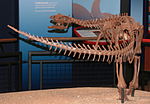Hypsilophodon (/ˌhɪpsɪˈlɒfoʊdɒn/; meaning "high-crested tooth") is a neornithischian dinosaur genus from the Early Cretaceous period of England. It has...
37 KB (4,281 words) - 09:26, 19 July 2024
Megalosauridae and Scelidosauridae), including within it the genera Iguanodon, Hypsilophodon, and Hadrosaurus, in addition to Cetiosaurus and tentatively Stenopelix...
17 KB (1,470 words) - 06:08, 25 June 2024
is an unnatural grouping which should only include the type genus, Hypsilophodon, with the other genera being within clades like Thescelosauridae and...
22 KB (1,691 words) - 21:57, 22 June 2024
gondwanicus and Talenkauen santacrucensis, provided that it does not include Hypsilophodon foxii, Iguanodon bernissartensis, or Thescelosaurus neglectus. Fonseca...
8 KB (402 words) - 15:54, 17 July 2024
Wessex Formation (section "Hypsilophodon bed")
associated with the plant debris beds, a notable exception is the "Hypsilophodon bed" present near the top of the formation, an up to 1 metre thick bed...
55 KB (3,575 words) - 09:02, 29 October 2024
Parksosauridae referring to all animals closer to Parksosaurus than Hypsilophodon, but they contained the same taxa so Boyd used Parksosauridae under...
14 KB (1,265 words) - 22:35, 1 November 2024
excavated the types of new dinosaur genera, including Aristosuchus, Hypsilophodon foxii, and Polacanthus. Most of the discoveries were then transferred...
6 KB (633 words) - 07:44, 28 June 2023
Pachycephalosauria and Ceratopsia, while the latter typically includes Hypsilophodon and the more derived Iguanodontia. Neornithischia was first named by...
13 KB (893 words) - 17:32, 3 October 2024
as a hypsilophodont, but more recently recognized as distinct from Hypsilophodon. Several species have been suggested for this genus. Three currently...
84 KB (9,457 words) - 15:45, 2 November 2024
excavation. Owen and Hooley subsequently described skin impressions of Hypsilophodon and Iguanodon in 1885 and 1917. Since then, scale impressions have been...
283 KB (28,268 words) - 18:11, 30 October 2024









